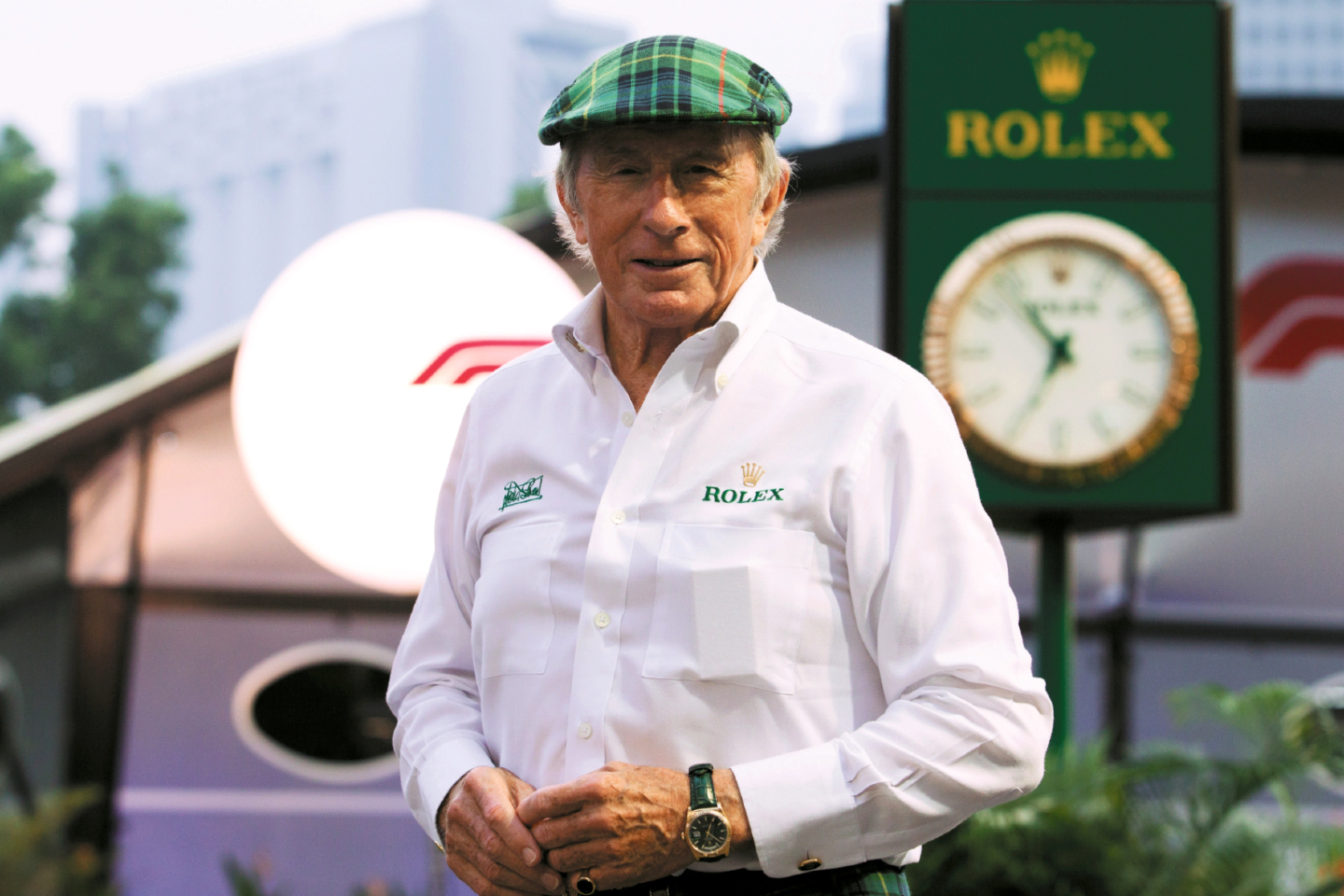
Rolex ambassador Stewart took the brand's media guests on a tour of the paddock (All photos: Rolex)
Sir Jackie Stewart was in the building. Even the most nonchalant guest at the Rolex suite stood to meet the Flying Scot, still revered as one of the greatest Formula 1 drivers despite retiring in 1973. The gold GMT Master on the seasoned Rolex ambassador’s wrist glinted as he signed autographs and posed for photographs. The timepiece was visible in each shot.
Of the five hospitality facilities that offer trackside views of the F1 Singapore Grand Prix, the Paddock Club is the most exclusive, with corporate bigwigs hosting VIP clients in their respective suites. As official timekeeper of the motorsports series, Rolex has the best seats in the house, directly overlooking the finish line.
Not that anyone was paying much attention to the thundering roars as the 20 drivers put in practice laps around the Marina Bay Street Circuit the day before the F1 Night Race. Exclusivity is a Rolex tenet that extends to experiences such as this, with a few tables spread across in the wood-panelled suite and free-flowing champagne and wine fostering conviviality among the guests, who comprise recognisable faces from the regional luxury world. Stewart relaxed at one such table, dining and chatting with guests.
f1singa19jm_212_1.jpg
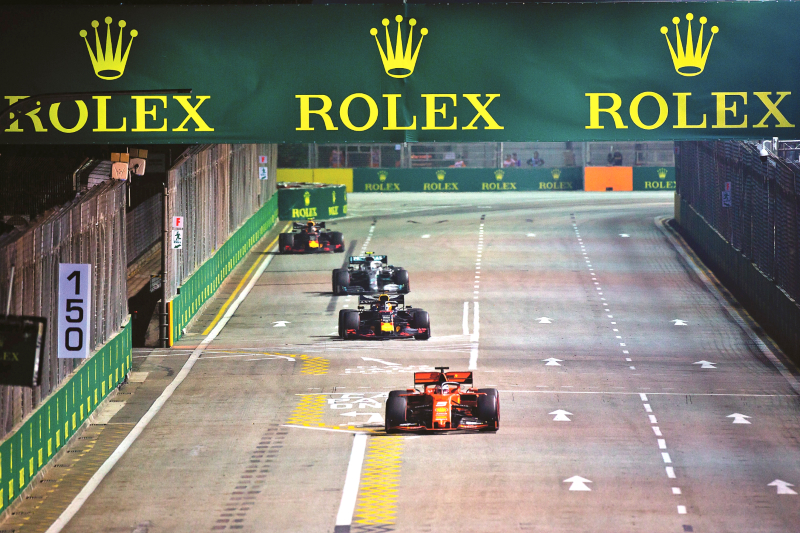
For the first-time F1 attendee, the suite is a strategic centre from which to explore Paddock Club, a lively hub of activity ripe for people watching. Perks of the all-access Paddock Club package include dedicated parking spots, entrance to a pit lane walk and admission to the entire Circuit Park, entertainment stages, lifestyle areas and special viewing platforms.
The late-afternoon heat and oppressive humidity made forays on foot to other sections of the circuit distinctly unappealing but there were distractions aplenty within the club.
Long lines snaked around booths for aura readings, portrait drawings, psychic consultations, massages at the COMO Shambhala Wellness lounge and impromptu poetry written on a theme of your choosing. Hunger pangs were kept at bay with ice cream or a pastry by Tarte by Cheryl Koh, while gourmands found satiation in pop-up restaurants including The Hind’s Head by Heston Blumenthal, Nobu and COMO Dempsey — all complimentary pleasures that were part of the package.
Although access is a Paddock Club premise, Rolex further elevates the proposition with exclusive opportunities such as a chance to tour the Renault pit. Lanyards in the carmaker’s signature Liquid Yellow signalled admission to the garage for a close-up view of the mechanics working on Daniel Ricciardo and Nico Hulkenberg’s cars. The action was quick but controlled, everyone moving with the purpose and synchrony of a well-oiled team.
A different kind of race
That efficiency can be applied to the entire traveling circus that is F1. Media guests at Rolex were whisked behind the scenes for an idea of the sheer scale of operations, orchestrated with military precision to make possible the quick turnarounds between races. Even as podium finishers were popping champagne and fireworks lit the sky, in the case of the Singapore Night Race, the garages were being cleared and race cars prepared for travel as the sporting extravaganza geared up to move on to its next location. In as little as eight hours after a Grand Prix ends, all traces of the race disappear.
Vital to this bit of nifty manoeuvring is official logistics partner DHL. Transporting 10 teams and 20 drivers for 21 races across five continents in nine months involves transporting 40 to 50 tonnes of freight and 10,000kg of electronics per team, 30 containers of hospitality equipment and 150,000kg of broadcast media equipment over land, air and sea. International events naturally raise greater logistical complications than the inter-European circuits. The most challenging turnaround is the mere week and 7,800km between the Singapore and Russia Grands Prix, but the choreography has been nailed down to a science.
f1singa19jm_067.jpg
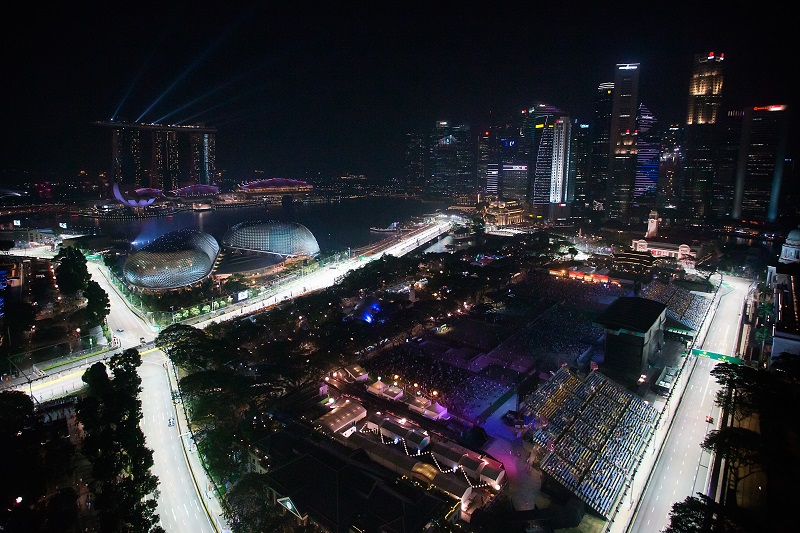
Priority pallets holding garage essentials such as computers and structures arrive first, on the Tuesday following the previous race, with custom checks sometimes executed on-site rather than at airports for efficiency. Access to crates is denied until all teams have received their essential cargo and the remainder freight — including the cars — typically arrive the next day. A veritable army of employees then prepare the circuit, pit lanes and paddocks, ensuring that they are operational by Thursday.
Bart Richardson of the technical team walked us through the Broadcast Centre that acts as the technical base and, as per its name, the place where live broadcasts are put together and post-race interviews are held. The outfit comprises two 50-tonne structures that are shipped on rotation ahead of events as well as aircraft-sized containers of single-set equipment that travel to all races. The containers are arranged in a 3x3 configuration, designed in such a way that the sides of each merely have to be lifted off (these will form the partitions in the centre) and they are ready to roll, with screens, tables and chairs affixed. As soon as the 30-man rigging team — who carry their own tools, generators and air conditioning (set at full blast to keep the computers cool) — establish the scene within two days, operations are taken over by about 220 people, ranging from cameramen to engineers.
The centre is a heady hub of technology that tracks every single bit of data relevant to the race, much of it fed through a fibre ring installed around the circuit. Richardson pointed out screens that monitor driver audio, the three on-board cameras (one always live) and two timing transponders (they log a unique ID every time the car passes over a timing loop buried under the track, accurate to ten thousandths of a second) on each car, the flow of information between garages and the tech centre and the 140 microphones around the circuit that deliver 5.1 surround sound.
mr-2018-azerbaijan-friday-006.jpg
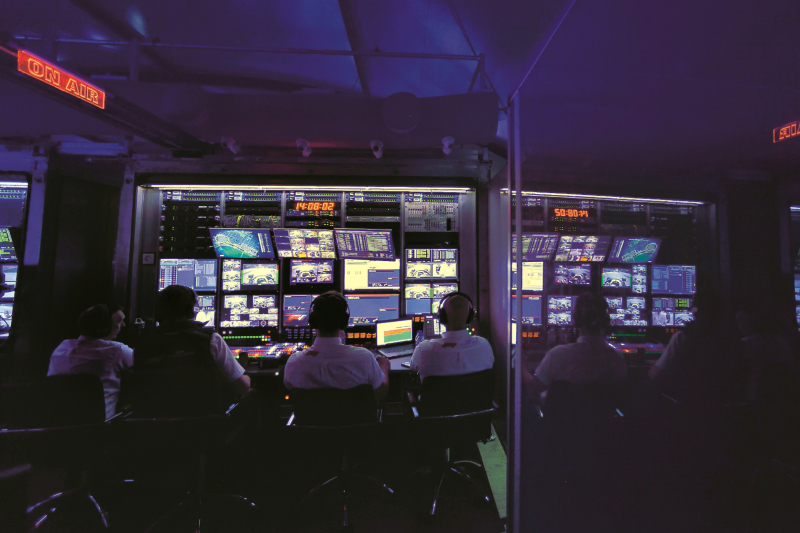
An impressive discovery is that colour balancing is done manually and instantaneously so that the colours of elements such as the sky and cars speeding through light and shadow during the night race match from frame to frame as the trackside cameras are progressively called into play. We can only imagine the salary the person(s) behind this feat must be pulling.
At 5.06km and with 23 corners, the Marina Bay Street Circuit is among the longer circuits on the calendar. Broadcasting the F1 is trickier than other sports because unless the safety car has been deployed, there are no natural breaks in the action and directors decide how to work replays into live showings. Picture-in-picture displays would further complicate the commentary and varying graphics, so instant judgement calls are necessary.
“The oil in this machine is the people,” Richardson affirmed as we shook hands at the door. “There is a great amount of trust and communication. That’s what makes our operation so slick and effective — and also fun.”
On the ground
And fun it was. The air thrummed with anticipation as we wandered down the street fenced by the hospitality suites of each carmaker and the back of their respective garages (the fronts form the trackside pit lanes). This is where Paddock Club fans might bump into their favourite drivers as they move between suite and garage or, as in our case, F1 CEO Chase Carey.
Carey, distinctive with his handlebar moustache, paused by our group for a chat as we were being given a grand tour by none other than Stewart himself. The latter certainly is a popular face around here, greeting stalwart F1 reporters by name, recognising a couple of zealous fans who travel to most races and graciously granting requests for autographs and photos.
“In the European season, you can really see the budgets for the various teams,” said Stewart, indicating the double-storey hospitality suites where the teams hang out on their breaks. “In Singapore, the suites are the same size but some of the European races showcase the pockets of the bigger boys like Mercedes, Ferrari and Red Bull. Now, the garages — F1 beats everyone on attention to detail. They are immaculately clean and everything is meticulously laid out in exactly the same place as they are in the workshops at home, so no time is wasted searching for tools or parts.”
f1singa19jm_257.jpg
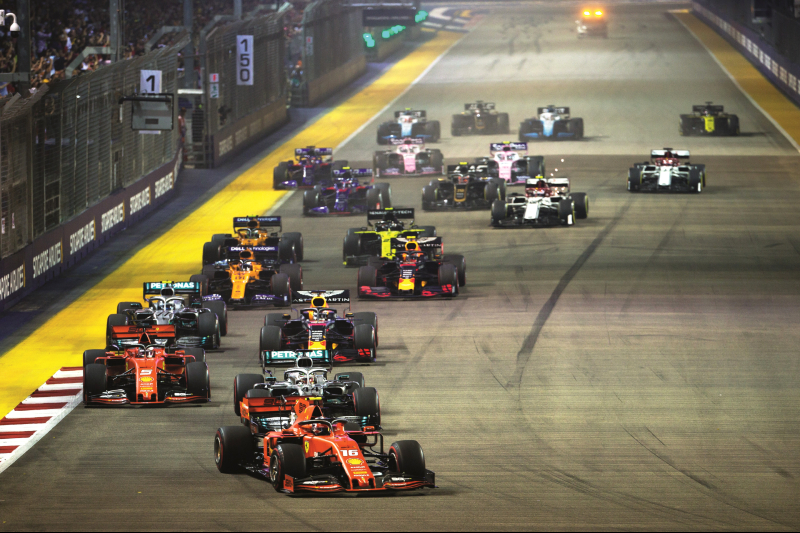
Stewart dispensed nuggets of information continuously, even pausing at a rack carrying the Pirelli tyres that outfit every F1 car. He showed us how they are heated to 80⁰C to 100⁰C for steady grip immediately upon flag off and the five tyre varieties suited to assorted conditions and surfaces.
Another stop was the back door of the Ferrari garage. “They really are something,” Stewart said, sharing how Ferrari race cars are equipped with over 200 sensors that send information not just to the pit and garage but also to the headquarters in Maranello, Italy. A team there scrutinises an on-site car — with a dummy driver of the same weight as the racer — that mimics the race car’s movements in real-time, in case the team on the ground misses any details amid the noise and activity.
We also trotted down to check out the safety cars deployed when incidents require intervention. A pair of Mercedes-AMG GT Rs serve this function, bearing top speeds of 250kmh to ensure a fast-enough pace during the safety period so the race cars’ tyres and brakes remain warm. Black stickers on the safety cars sport “Thank you Charlie”, as a tribute to the late race director Charlie Whiting, who passed away suddenly in March at the Australia Grand Prix in Melbourne.
A helluva show
Stewart put in an appearance at the Rolex suite again on race day, this time in the company of Australian former driver Mark Webber. The mood was jolly as the sky darkened and guests pressed against the glass viewing panel overlooking the starting line for the flag off, as Ferrari driver and favourite Charles Leclerc took pole position. He was closely followed by Lewis Hamilton (Mercedes), Sebastian Vettel (Ferrari) and Max Verstappen (Red Bull Racing Honda).
Singapore has traditionally been fortuitous for Vettel, who had tied with Hamilton for the most number of wins here (four each) since the island entered the F1 calendar in 2008. The 2019 race saw the former pull ahead as the Prancing Horse leapt into first place, with Leclerc a close second in a whopping triumph for Scuderia fans.
f1singa19jm_251.jpg
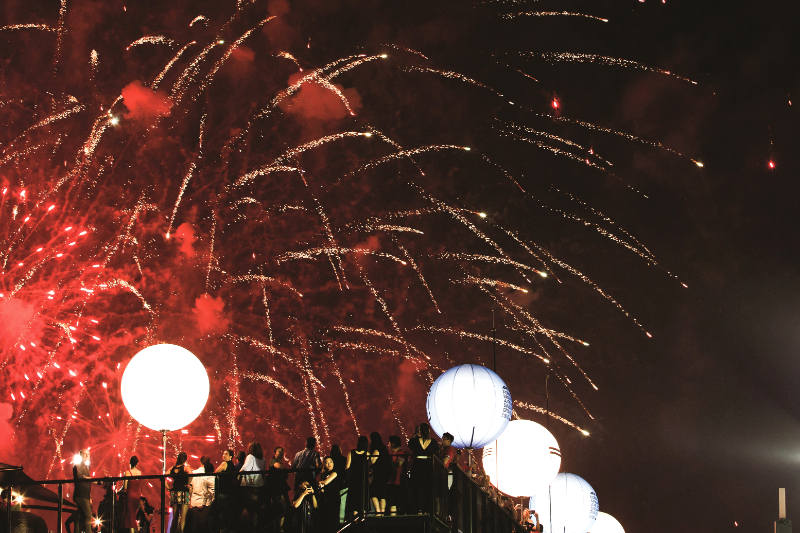
At the deciding minutes of high-octane manoeuvring, Rolex guests were ushered trackside to anticipate the celebratory moments of the awards ceremony. Upon clearing the circuit of speeding cars, we then joined the official press and crews as the victors pulled in, giving us a front-row view of the post-race commotion as an ecstatic Vettel sprang out to greet his cheering supporters. Leclerc, although disgruntled over the radio at strategy calls that lost him his pole start, congratulated his teammate and the two went upstairs to receive their trophies.
Verstappen completed the podium finish and the trio were in high spirits as they splashed each other with celebratory champagne. Even as fireworks exploded across the sky, showering the Singaporean skyline with bursts of colour and revelry, figures in the shadows were already packing up the cars. One race down, six more to go.
This article first appeared on Oct 21, 2019 in The Edge Malaysia.


